#neo-elamite
Explore tagged Tumblr posts
Photo

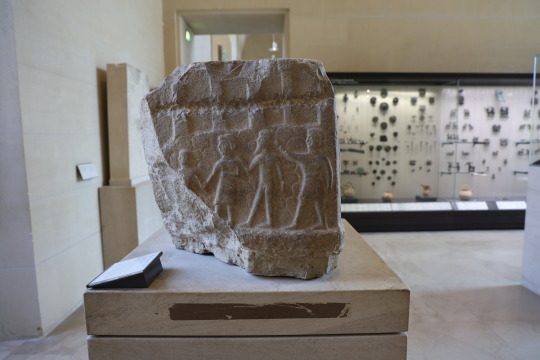
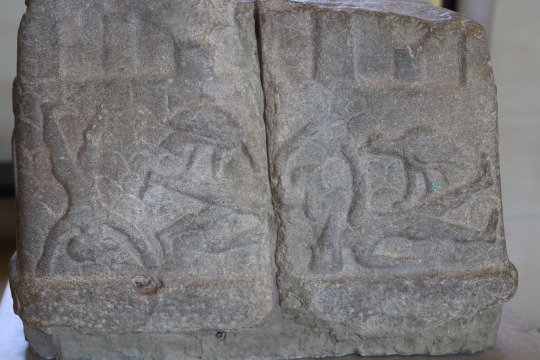
Basalt pedestal depicting scenes of slain combatants being eaten by vultures, captives being led away and killed Neo-Elamite period, 7th-6th century BCE Susa, Iran
Musée du Louvre, Sb 5
92 notes
·
View notes
Text

rhyton in the shape of a zebu bull | c. 1000 - 800 BCE | iran, neo-elamite period, amlash culture
in the indianapolis museum of art at newfields collection
74 notes
·
View notes
Text
I had the sanctuaries of the land Elam utterly destroyed and I counted its gods and its goddesses as ghosts. I destroyed and devastated the tombs of their earlier and later kings. I took their bones to Assyria. I prevented their ghosts from sleeping and deprived them of funerary-offerings and libations of on a march of one month and twenty-five days. I devastated the districts of the land Elam and scattered salt and cress over them. As for the rest of the people, those still alive I myself now laid flat those people there as a funerary-offering. I fed their dismembered flesh to dogs, pigs, vultures, eagles, birds of the heavens and fish the apsû. What was left of the feast of the dogs and swine, of their members which blocked the streets and filled the squares, I ordered them to remove from Babylon, Kutha and Sippar, and to cast them upon heaps. The nobles and elders of the city came out to me to save their lives they seized my feet and said, “If it pleases you, kill. If it pleases you, spare. If it pleases you, do what you will in strife and conflict.” I besieged and conquered the city. I felled three thousands of their fighting men with the sword. I captured many troops alive. I cut off some their arms and hands. I cut off of others their noses earth and extremities. I gouged out the eyes of so many troops. I made one pile of the living and one of heads I hung their heads on trees around the city I felled fifty of their fighting men with the sword, burnt two hundred captives from them and defeated in a battle on the plain three hundred and thirty-two troops. With their blood I dyed the mountain red like red wool and the rest of them, the ravines and torrents of the mountain swallowed. I carried off captives and possessions from them. I cut off the heads of their fighters and built there with a tower before their city, I burned their young men, women, and children to death. I flayed as many nobles as had rebelled against me and draped their skins over the pile of corpses. Some I spread out within the pile; some I erected on stakes upon the pile. I flayed many right through my land and draped their skins over the walls. I cut their throats like lambs. I cut off their precious lives as one guts a string. Like the many waters of the storm, I made the contents of their gullets and entrails run down upon the wide earth. My prancing steeds harnessed from the riding, plunged into the streams of their blood as into a river. The wheels of my war chariot, which brings low the wicked and evil, where bespattered with blood and filth. With the bodies of their warriors, I filled the plain, like grass. Their testicles I cut off and tore out their privates like the seeds of cucumbers. Their blood, like a broken dam, I caused to flow down the mountain gullies. I hung the heads of Sanduarri and Abdi-Milkutti on the shoulders of their nobles and, with singing and music, I paraded through the public square of Nineveh.
— Ashurbanipal, King of the Neo-Assyrian Empire's account of his destruction of the Elamites
The Assyrian conquest of Elam took place in 639 BCE. Elam was destroyed completely, but the Neo-Assyrian Empire itself did not long survive them and was conquered thirty-four years later by the Neo-Babylonian king, Nabopolassar, and Cyaxares, King of Media.
4 notes
·
View notes
Photo
Cylinder seals are cylindrical objects carved in reverse (intaglio) in order to leave raised impressions when rolled into clay. Seals were generally used to mark ownership, and they could act as official identifiers, like a signature, for individuals and institutions. A seal’s owner rolled impressions in wet clay to secure property such as baskets, letters, jars, and even rooms and buildings. This clay sealing prevented tampering because it had to be broken in order to access a safeguarded item. Cylinder seals were often made of durable material, usually stone, and most were drilled lengthwise so they could be strung and worn. A seal’s material and the images inscribed on the seal itself could be protective. The artistry and design might be appreciated and considered decorative as well. Cylinder seals were produced in the Near East beginning in the fourth millennium BCE and date to every period through the end of the first millennium BCE.
-
Mesopotamia, 3000-2700 B.C.
Tools and Equipment; seals
Black marble
-
This seal illustrates a scene with the goddess Ishtar welcoming a devotee. A cuneiform inscription is incorporated into the scene.



Cylinder seals of the ancient Near East
Invented in southern Mesopotamia (modern Iraq) about 3500 BC, cylinder seals were used as magical amulets, administrative tools, and jewellery. These small cylinders had a design carved in intaglio, and a hole through them, enabling them to be worn on string.
When these seals were rolled onto clay, a continuous impression was left of the design. Shown here are three such examples of these impressions, with the cylinder seal itself alongside the second example. The first example dates to 800-600 BC (Neo-Elamite), the second is the oldest at 3000-2700 BC, and the third, ca. 700 BC (Achaemenid).
The Walters provides the following description for the first example:
In the 8th and 7th centuries BC, Elam, to the east of Mesopotamia in Iran, experienced a brief period of prosperity during which it allied itself with Babylonia against Assyria. The seals produced in Elam during this period reflect themes derived from Mesopotamia, such as the lion hunt seen here; however, the strong modeling, the almost decorative patterning of the details, and the exaggerated posture of the lion characterize the local Elamite style.
Cylinder Seal with a Lion Hunt, courtesy of the Walters Art Museum, Baltimore: 42.797.
Cylinder Seal, courtesy of the LACMA: M.71.73.11c.
Cylinder Seal with Ishtar Welcoming a Devotee, courtesy of the Walters Art Museum, Baltimore: 42.782.
#history#art#art history#economics#trade#commerce#jewellery#languages#neo-elamite period#mesopotamia#elam#achaemenid empire#babylonia#neo-babylonian empire#neo-assyrian empire#iraq#iran#ishtar#cylinder seals#marble#cuneiform#cylinder seal ref
814 notes
·
View notes
Photo
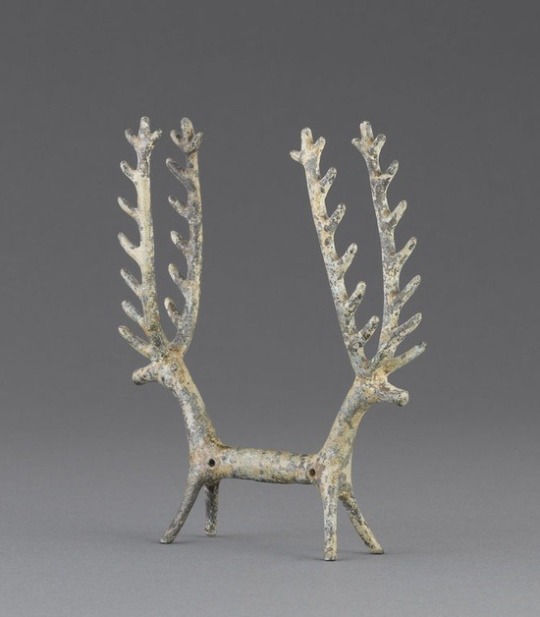
Double figurine composed of the fore-quarters of facing cervids
Bronze, Iran in the Iron Age (14th–mid-6th century BC) and during the Neo-Elamite dynasties
3K notes
·
View notes
Text
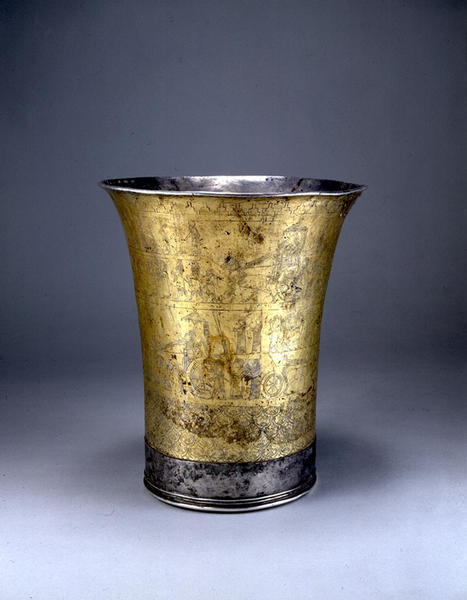

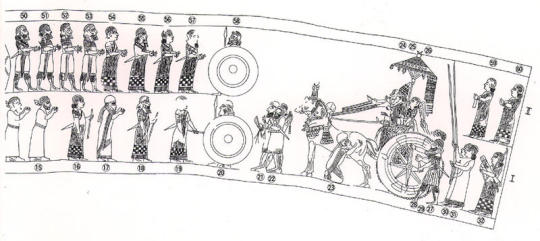
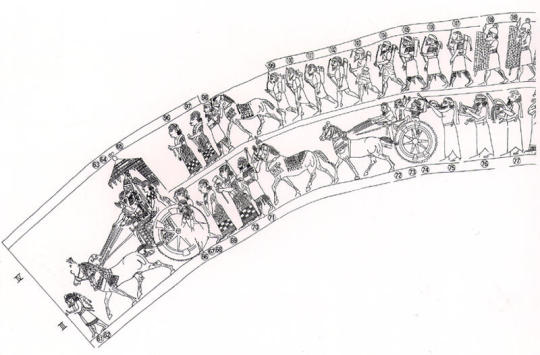
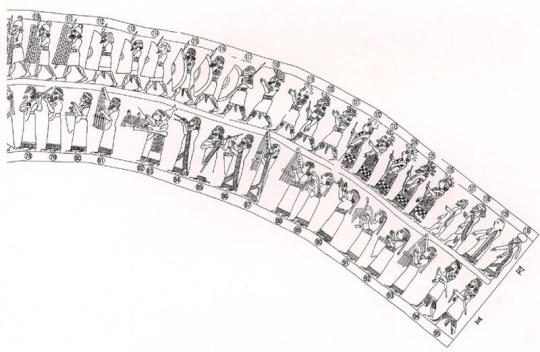
Gilded silver cup depicting the Assyrian subjugation of the Elamites, Neo-Assyrian Empire, 8th-7th century BC.
from The Miho Museum, Kyoto
276 notes
·
View notes
Text

Gate of All Nations The Gate of Xerxes -UNESCO World Heritage (r. 486 – 465 BC) Persepolis - IRAN
The bronze trumpets that once signaled the arrival of important foreign delegations to Persepolis, the ceremonial capital of the mighty Achaemenid Empire, may now be silent, but it is still possible to capture the sense of awe while visiting the colossal Gate of Xerxes.
Built during the reign of Achaemenid king Xerxes I , who called this his Gate of All Nations, the pillared entrance is guarded by bearded and hoofed mythical figures in the style of Assyrian gate-guards.
On arrival at Persepolis one is confronted by an imposing wall, completely smooth and plain, about 15 meters tall: this is the artificial terrace on which the palaces were built. This vast terrace of Persepolis, some 450 meters long and 300 meters wide, was originally fortified on three sides by a tall wall. The only access was from the monumental staircase, which leads to the Gate of All Nations.
The gateway bears a cuneiform inscription in Old Persian, Neo-Babylonian, and Elamite languages declaring, among other things, that Xerxes is responsible for the construction of this and many beautiful wonders in Persia. Centuries of graffitists have also left their mark, including explorer Henry Morton Stanley.
A pair of colossal bulls guarded the western entrance; two man-bulls stood at the eastern doorway. Engraved above each of the four colossi is a trilingual inscription attesting to Xerxes having built and completed the gate. The doorway on the south, opening toward the Apadana, is the widest of the three.
According to sources, pivoting devices found on the inner corners of all the doors indicate that they must have had two-leaved doors, which were probably made of wood and covered with sheets of ornamented metal.
Persepolis, also known as Takht-e Jamshid, whose magnificent ruins rest at the foot of Kuh-e Rahmat ("Mountain of Mercy"), was the ceremonial capital of the Achaemenid Empire. It is situated 60 kilometers northeast of the city of Shiraz in Fars Province.
Persepolis was the seat of the government of the Achaemenid Empire, though it was designed primarily to be a showplace and spectacular center for the receptions and festivals of the kings and their empire.
The royal city ranks among the archaeological sites which have no equivalent, considering its unique architecture, urban planning, construction technology, and art.
The city was burnt by Alexander in 330 BC apparently as revenge to the Persians
The immense terrace of Persepolis was begun about 518 BC by Darius the Great, the Achaemenid Empire’s king. On this terrace, successive kings erected a series of architecturally stunning palatial buildings, among them the massive Apadana palace and the Throne Hall (“Hundred-Column Hall”).
This 13-ha ensemble of majestic approaches, monumental stairways, throne rooms (Apadana), reception rooms, and dependencies is classified among the world’s greatest archaeological sites.
#art#design#doorway#architecture#heavensdoorways#gateway#entryway#iran#persepolis#bull#royal#royal city#style#history#gates of xerses#unesco world heritage#monumental#gate of all nations#achaemenid#persia#xerxes#front door#architrave
87 notes
·
View notes
Text
Pillar figurine—Lachish, Judah (now Israel/Palestine), 8th to 7th century BCE

According to the Met: "This type of pillar figurine is typical of those produced in great numbers in the kingdom of Judah at this time. Tell el-Duweir is ancient Lachish, the major fortified center in Judah that was destroyed by the Assyrian army under Sennacherib (701 B.C.). The city's fate is chronicled in the Bible and represented in wall reliefs from the Assyrian palace at Nineveh. This buxom goddess figurine with pillar base is nude and supports her breasts in her hands. The head is simply rendered with a short, tightly curled caplike hairdo articulated in ridges, and the facial features are mold-made and clearly articulated. This imagery and that on clay plaques with nude female figures probably represents fertility or mother goddesses. The figurines are found in domestic contexts and point to popular cults that coexisted with monotheistic Judaism. Outside influences are evident in the religion of ancient Israel and Judah at this time, and Syrian cults focusing on the worship of Asherah may have been an influence. Asherah was the wife of El, head of the Canaanite pantheon, and probably the mother of the gods in Canaanite and later Jewish tradition. Some literary evidence in ancient Israel even speaks of Asherah as the consort of Hashem [the Met includes the tetragrammaton here] himself."
Here are some other female figurines in the Met's collection that use similar poses and come from surrounding areas.

This statue from northwestern Iran in the early first millennium BCE.

^ This Mesopotamian or Syrian figure from much earlier, around 5600-5000 BCE.

^ This Neo-Elamite part of a vessel from Southwestern Iran around the same time as the Judean Pillar Statues (8th-7th century BCE).

Another vessel in the shape of a woman from Northwestern Iran, also around the time of the Judean Pillar Statues (9th-7th century BCE).
#judean pillar statues#jewish history#ancient art#ancient history#jewish#jewish art#israel#israel/palestine#iran#ancient iran#mesopotamia#judah#ancient syria
16 notes
·
View notes
Text
Countries that are no more: Achaemenid Empire (550BC-330BC)
It was not the first empire of Iranian peoples, but it arose as probably the greatest in terms of influence and became the measure by which all subsequent Iranian empires tended to compare themselves and its influence on culture, government & civil infrastructure would influence others beyond the span of its territory and the span of time. This is the Achaemenid Empire.
Name: In Old Persian it was known as Xšāça or the "The Kingdom or the Empire", it was named the Achaemenid Empire by later historians. Named after the ruling dynasty established by its founder Cyrus the Great who cited the name of his ancestor Haxāmaniš or Achaemenes in Greek as progenitor of the dynasty. It is sometimes also referred to as the First Persian Empire. The Greeks simply referred to it as Persia, the name which stuck for the geographic area of the Iranian plateau well into the modern era.
Language: Old Persian & Aramaic were the official languages. With Old Persian being an Iranian language that was the dynastic language of the Achaemenid ruling dynasty and the language of the Persians, an Iranian people who settled in what is now the southwestern Iranian plateau or southwest Iran circa 1,000 BC. Aramaic was a Semitic language that was the common and administrative language of the prior Neo-Assyrian & Neo-Babylonian Empires which centered in Mesopotamia or modern Iraq, Syria & Anatolian Turkey. After the Persian conquest of Babylon, the use of Aramaic remained the common tongue within the Mesopotamian regions of the empire, eventually becoming a lingua franca across the land. As the empire spread over a vast area and became increasingly multiethnic & multicultural, it absorbed many other languages among its subject peoples. These included the Semitic languages Akkadian, Phoenician & Hebrew. The Iranian language of Median among other regional Iranian languages (Sogdian, Bactrian etc). Various Anatolian languages, Elamite, Thracian & Greek among others.
Territory: 5.5 million kilometers squared or 2.1 million square miles at its peak circa 500BC. The Achaemenid Empire spanned from southern Europe in the Balkans (Greece, Bulgaria, European Turkey) & northwest Africa (Egypt, Libya & Sudan) in the west to its eastern stretches in the Indus Valley (Pakistan) to parts of Central Asia in the northeast. It was centered firstly in the Iranian Plateau (Iran) but also held capitals in Mesopotamia (Iraq). Territory was also found in parts of the Arabian Peninsula & the Caucausus Mountains.
Symbols & Mottos: The Shahbaz or Derafsh Shahbaz was used as the standard of Cyrus the Great, founder of the empire. It depicts a bird of prey, typically believed to be a falcon or hawk (occasionally an eagle) sometimes rendered gold against a red backdrop and depicts the bird holding two orbs in its talons and adorned with an orb likewise above its head. The symbolism was meant to depict the bird guiding the Iranian peoples to conquest and to showcase aggression & strength coupled with dignity. The imperial family often kept falcons for the pastime of falconry.
Religion: The ancient Iranian religion of Zoroastrianism served as the official religion of the empire. It was adopted among the Persian elite & and had its unique beliefs but also helped introduce the concept of free-will among its believers, an idea to influence Judaism, Christianity & Islam in later centuries. Despite this official religion, there was a tolerance for local practices within the subject regions of the empire. The ancient Mesopotamian religion in Babylon & Assyria, Judaism, the Ancient Greek & Egyptian religions & Vedic Hinduism in India was likewise tolerated as well. The tolerance of the Achaemenids was considered a relative hallmark of their dynasty from the start. Famously, in the Old Testament of the Bible it was said that it was Cyrus the Great who freed the Jews from their Babylonian captivity and allowed them to return to their homeland of Judea in modern Israel.
Currency: Gold & silver or bimetallic use of coins became standard within the empire. The gold coins were later referred to as daric and silver as siglos. The main monetary production changes came during the rule of Darius I (522BC-486BC). Originally, they had followed the Lydian practice out of Anatolia of producing coins with gold, but the practice was simplified & refined under the Achaemenids.
Population: The estimates vary ranging from a low end of 17 million to 35 million people on the upper end circa 500BC. The official numbers are hard to determine with certainty but are generally accepted in the tens of millions with the aforementioned 17-35 million being the most reasonable range based on available sources.
Government: The government of the Achaemenid Empire was a hereditary monarchy ruled by a king or shah or later referred to as the ShahanShah or King of Kings, this is roughly equivalent to later use of the term Emperor. Achaemenid rulers due the unprecedented size of their empire held a host of titles which varied overtime but included: King of Kings, Great King, King of Persia, King of Babylon, Pharaoh of Egypt, King of the World, King of the Universe or King of Countries. Cyrus the Great founded the dynasty with his conquest first of the Median Empire and subsequently the Neo-Babylonians and Lydians. He established four different capitals from which to rule: Pasargadae as his first in Persia (southwest central Iran), Ecbatana taken from the Medians in western Iran's Zagros Mountains. The other two capitals being Susa in southwest Iran near and Babylon in modern Iraq which was taken from the Neo-Babylonians. Later Persepolis was made a ceremonial capital too. The ShahanShah or King of Kings was also coupled with the concept of divine rule or the divinity of kings, a concept that was to prove influential in other territories for centuries to come.
While ultimate authority resided with the King of Kings and their bureaucracy could be at times fairly centralized. There was an expansive regional bureaucracy that had a degree of autonomy under the satrapy system. The satraps were the regional governors in service to the King of Kings. The Median Empire had satraps before the Persians but used local kings they conquered as client kings. The Persians did not allow this because of the divine reverence for their ShahanShah. Cyrus the Great established governors as non-royal viceroys on his behalf, though in practice they could rule like kings in all but name for their respective regions. Their administration was over their respective region which varied overtime from 26 to 36 under Darius I. Satraps collected taxes, acted as head over local leaders and bureaucracy, served as supreme judge in their region to settle disputes and criminal cases. They also had to protect the road & postal system established by the King of Kings from bandits and rebels. A council of Persians were sent to assist the satrap with administration, but locals (non-Persian) could likewise be admitted these councils. To ensure loyalty to the ShahanShah, royal secretaries & emissaries were sent as well to support & report back the condition of each satrapy. The so called "eye of the king" made annual inspections of the satrapy to ensure its good condition met the King of Kings' expectations.
Generals in chief were originally made separate to the satrap to divide the civil and military spheres of government & were responsible for military recruitment but in time if central authority from the ShahanShah waned, these could be fused into one with the satrap and general in chiefs becoming hereditary positions.
To convey messages across the widespread road system built within the empire, including the impressive 2,700 km Royal Road which spanned from Susa in Iran to Sardis in Western Anatolia, the angarium (Greek word) were an institution of royal messengers mounted on horseback to ride to the reaches of the empire conveying postage. They were exclusively loyal to the King of Kings. It is said a message could be reached to anywhere within the empire within 15 days to the empire's vast system of relay stations, passing message from rider to rider along its main roads.
Military: The military of the Achaemenids consisted of mostly land based forces: infantry & cavalry but did also eventually include a navy.
Its most famous unit was the 10,000-man strong Immortals. The Immortals were used as elite heavy infantry were ornately dressed. They were said to be constantly as 10,000 men because for any man killed, he was immediately replaced. Armed with shields, scale armor and with a variety of weapons from short spears to swords, daggers, slings, bows & arrows.
The sparabara were the first line of infantry armed with shields and spears. These served as the backbone of the army. Forming shield walls to defend the Persian archers. They were said to ably handle most opponents and could stop enemy arrows though their shields were vulnerable to enemy spears.
There was also the takabara light infantry and though is little known of them it seems they served as garrison troops and skirmishers akin to the Greek peltast of the age.
The cavalry consisted of four distinct groups: chariot driven archers used to shoot down and break up enemy formations, ideally on flat grounds. There was also the traditional horse mounted cavalry and also camel mounted cavalry, both served the traditional cavalry functions and fielded a mix of armor and weapons. Finally, there was the use of war elephants which were brought in from India on the empire's eastern reaches. These provided archers and a massive way to physically & psychologically break opposing forces.
The navy was utilized upon the empire's reaching the Mediterranean and engaged in both battles at sea and for troop transport to areas where troops needing deploying overseas, namely in Greece.
The ethnic composition of Achaemenid military was quite varied ranging from a Persian core with other Iranian peoples such as the Medians, Sogdian, Bactrians and Scythians joining at various times. Others including Anatolians, Assyrians, Babylonians, Anatolians, Indians, Arabs, Jews, Phoenicians, Thracians, Egyptians, Ethiopians, Libyans & Greeks among others.
Their opponents ranged from the various peoples they conquered starting with the Persian conquest of the Medians to the Neo-Babylonians, Lydians, Thracians, Greeks, Egyptians, Arabs & Indians and various others. A hallmark of the empire was to allow the local traditions of subjugated areas to persist so long as garrisons were maintained, taxes were collected, local forces provided levies to the military in times of war, and they did not rebel against the central authority.
Economy: Because of the efficient and extensive road system within the vast empire, trade flourished in a way not yet seen in the varied regions it encompassed. Tax districts were established with the satrapies and could be collected with relative efficiency. Commodities such as gold & jewels from India to the grains of the Nile River valley in Egypt & the dyes of the Phoenicians passed throughout the realm's reaches. Tariffs on trade & agricultural produce provided revenue for the state.
Lifespan: The empire was founded by Cyrus the Great circa 550BC with his eventual conquest of the Median & Lydian Empires. He started out as Cyrus II, King of Persia a client kingdom of the Median Empire. His reign starting in 559BC. Having overthrown and overtaken the Medians, he turned his attention Lydia and the rest of Anatolia (Asia Minor). He later attacked the Eastern Iranian peoples in Bactria, Sogdia and others. He also crossed the Hindu Kush mountains and attacked the Indus Valley getting tribute from various cities.
Cyrus then turned his attention to the west by dealing with the Neo-Babylonian Empire. Following his victory in 539BC at the Battle of Opis, the Persians conquered the Babylonia with relative quickness.
By the time of Cyrus's death his empire had the largest recorded in world history up to that point spanning from Anatolia to the Indus.
Cyrus was succeeded by his sons Cambyses II and Bardiya. Bardiya was replaced by his distant cousin Darius I also known as Darius the Great, whose lineage would constitute a number of the subsequent King of Kings.
Darius faced many rebellions which he put down in succession. His reign is marked by changes to the currency and the largest territorial expansion of the empire. An empire at its absolute zenith. He conquered large swaths of Egypt, the Indus Valley, European Scythia, Thrace & Greece. He also had exploration of the Indian Ocean from the Indus River to Suez Egypt undertaken.
The Greek kingdom of Macedon in the north reaches of the Hellenic world voluntarily became a vassal of Persia in order to avoid destruction. This would prove to be a fateful first contact with this polity that would in time unite the Greek-speaking world in the conquest of the Achaemenid Empire. However, at the time of Darius I's the reign, there were no early indications of this course of events as Macedon was considered even by other Greek states a relative backwater.
Nevertheless, the Battle of Marathon in 490BC halted the conquest of mainland Greece for a decade and showed a check on Persia's power in ways not yet seen. It is also regarded as preserving Classical Greek civilization and is celebrated to this day as an important in the annals of Western civilization more broadly given Classical Greece & in particular Athens's influence on western culture and values.
Xerxes I, son of Darius I vowed to conquer Greece and lead a subsequent invasion in 480BC-479BC. Xerxes originally saw the submission of northern Greece including Macedon but was delayed by the Greeks at the Battle of Thermopylae, most famously by Spartan King Leonidas and his small troop (the famed 300). Though the Persians won the battle it was regarded as a costly victory and one that inspired the Greeks to further resistance. Though Athens was sacked & burnt by the Persians, the subsequent victories on sea & land at Salamis & Plataea drove the Persians back from control over Greece. Though war would rage on until 449BC with the expulsion of the Persians from Europe by the Greeks.
However, the Greeks found themselves in a civil war between Athens & Sparta and Persia having resented the Athenian led coalition against their rule which had expelled them from Europe sought to indirectly weaken the Greeks by supporting Greek factions opposed to Athens through political & financial support.
Following this reversal of fortune abroad, the Achaemenid Empire not able to regain its foothold in Europe, turned inward and focused more on its cultural development. Zoroastrianism became the de-facto official religion of the empire. Additionally, architectural achievements and improvements in its many capitals were undertaken which displayed the empire's wealth. Artaxerxes II who reigned from 405BC-358BC had the longest reign of any Achaemenid ruler and it was characterized by relative peace and stability, though he contended with a number of rebellions including the Great Satraps Revolt of 366BC-360BC which took place in Anatolia and Armenia. Though he was successful in putting down the revolt. He also found himself at war with the Spartans and began to sponsor the Athenians and others against them, showcasing the ever dynamic and changing Greco-Persian relations of the time.
Partially for safety reasons, Persepolis was once again made the capital under Artaxerxes II. He helped expand the city and create many of its monuments.
Artaxerxes III feared the satraps could no longer be trusted in western Asia and ordered their armies disbanded. He faced a campaign against them which suffered some initial defeats before overcoming these rebellions, some leaders of which sought asylum in the Kingom of Macedon under its ruler Philip II (father of Alexander the Great).
Meanwhile, Egypt had effectively become independent from central Achaemenid rule and Artaxerxes III reinvaded in around 340BC-339BC. He faced stiff resistance at times but overcame the Egyptians and the last native Egyptian Pharaoh Nectanebo II was driven from power. From that time on ancient Egypt would be ruled by foreigners who held the title Pharaoh.
Artaxerxes III also faced rebellion from the Phoenicians and originally was ejected from the area of modern coastal Lebanon, Syria & Israel but came back with a large army subsequently reconquered the area including burning the Phoenician city of Sidon down which killed thousands.
Following Artaxerxes III's death his son succeeded him but a case of political intrigue & dynastic murder followed. Eventually Darius III a distant relation within the dynasty took the throne in 336BC hoping to give his reign an element of stability.
Meanwhile in Greece, due to the military reforms and innovations of Philip II, King of Macedon, the Greek speaking world was now unified under Macedon's hegemony. With Philip II holding the title of Hegemon of the Hellenic League, a relatively unified coalition of Greek kingdoms and city-states under Macedon premiership that formed to eventually invade Persia. However, Philip was murdered before his planned invasion of Asia Minor (the Achaemenid's westernmost territory) could commence. His son Alexander III (Alexander the Great) took his father's reforms and consolidated his hold over Greece before crossing over to Anatolia himself.
Darius III had just finished reconquering some rebelling vestiges of Egypt when Alexander army crossed over into Asia Minor circa 334BC. Over the course of 10 years Alexander's major project unfolded, the Macedonian conquest of the Persian Empire. He famously defeated Persians at Granicus, Issus and Gaugamela. The latter two battles against Darius III in person. He took the King of Kings family hostage but treated them well while Darius evacuated to the far eastern reaches of his empire to evade capture. He was subsequently killed by one of his relatives & satraps Bessus, whom Alexander eventually had killed. Bessus had declared himself King of Kings though this wasn't widely recognized and most historians regard Darius III, the last legitimate ShahanShah of Achaemenids.
Alexander had taken Babylon, Susa & Persepolis by 330BC and effectively himself was now ruler of the Persian Empire or at least its western half. In addition to being King of Macedon & Hegemon of the Hellenic League, he gained the titles King of Persia, Pharaoh of Egypt & Lord of Asia. Alexander would in time eventually subdue the eastern portions of the Achaemenid realm including parts of the Indus Valley before turning back to Persia and Babylon where he subsequently became ill and died in June 323BC at age 32. Alexander's intentions it appears were never to replace the Achaemenid government & cultural structure, in fact he planned to maintain and hybridize it with his native Greek culture. He was in fact an admirer of Cyrus the Great (even restoring his tomb after looting) & adopted many Persian customs and dress. He even allowed the Persians to practice their religion and had Persian and Greeks start to serve together in his army. Following his death and with no established successor meant the empire he established which essentially was the whole Achaemenid Empire's territory in addition to the Hellenic world fragmented into different areas run by his most trusted generals who established their own dynasties. The Asian territories from Anatolia to the Indus (including Iran and Mesopotamia) gave way to the Hellenic ruled Seleucid Empire while Egypt became the Hellenic ruled Ptolemaic Kingdom. The synthesis of Persian and Greek cultures continued in the Seleucid and Greco-Bactrian kingdoms of antiquity.
The Achaemenid Empire lasted for a little over two centuries (550BC-330BC) but it casted a long shadow over history. Its influence on Iran alone has persisted into the modern age with every subsequent Persian Empire claiming to be its rightful successor from the Parthian & Sasanian Empires of pre-Islamic Iran to the Safavids of the 16th-18th century and the usage of the title Shah until the last Shah's ejection from power in the 1979 Islamic Revolution. Even the modern Islamic Republic of Iran uses Achaemenid imagery in some military regiments and plays up its importance in tourism and museums as a source of pride to Persian (Farsi) & indeed Iranian heritage. Likewise, its form of governance and the pushing of the concept of divine rights of kings would transplant from its Greek conquerors into the rest of Europe along with various other institutions such as its road & mail system, tax collection & flourishing trade. Its mix of centralized & decentralized governance. Its religious & cultural tolerance of local regions even after their conquest would likewise serve as a template for other empires throughout history too. The Achaemenid Empire served as a template for vast international & transcontinental empires that would follow in its wake & surpass its size & scope of influence. However, it is worth studying for in its time, it was unprecedented, and its innovations so admired by the likes of Alexander the Great and others echo into the modern era.
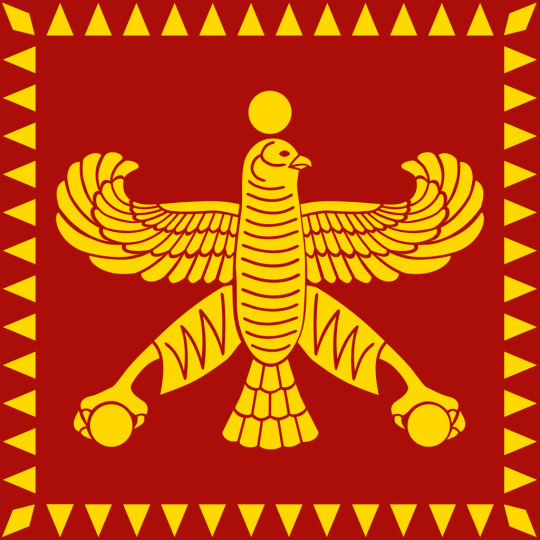
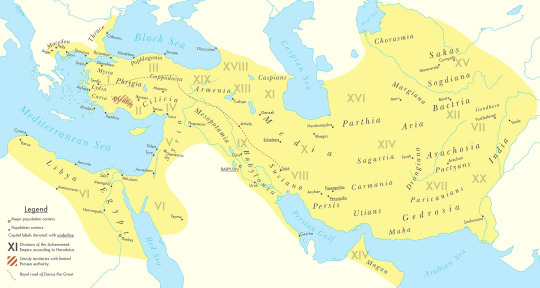

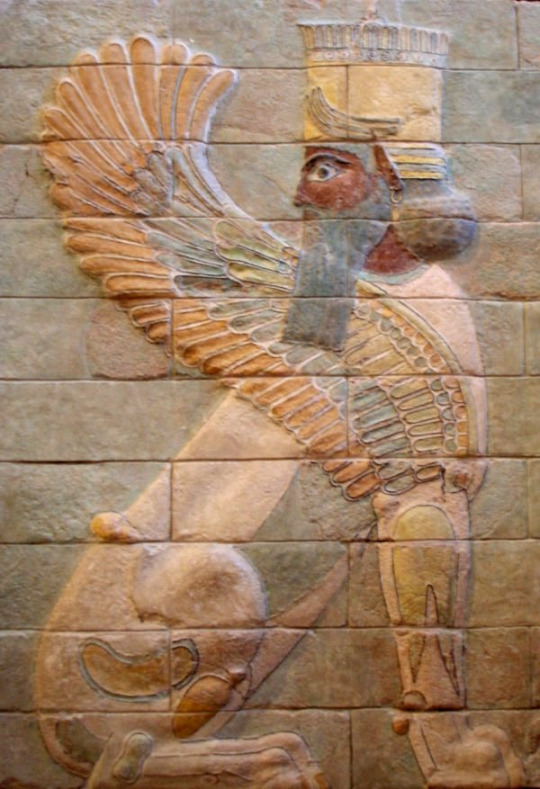
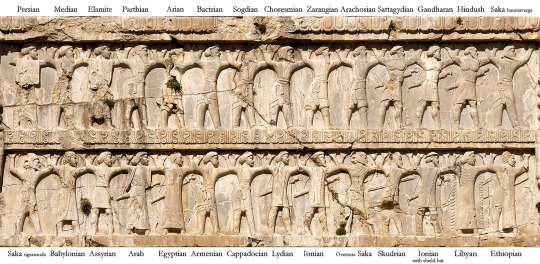
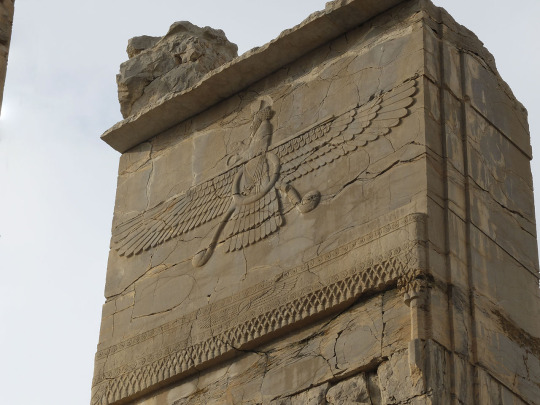
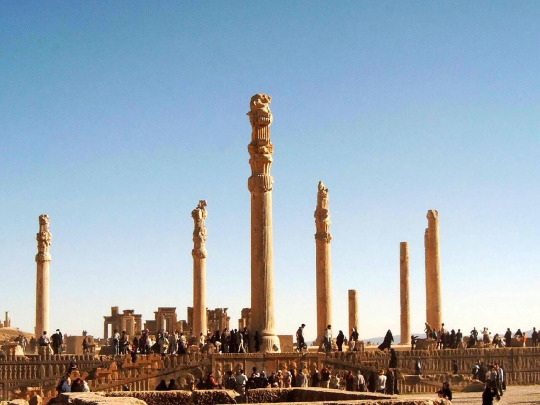
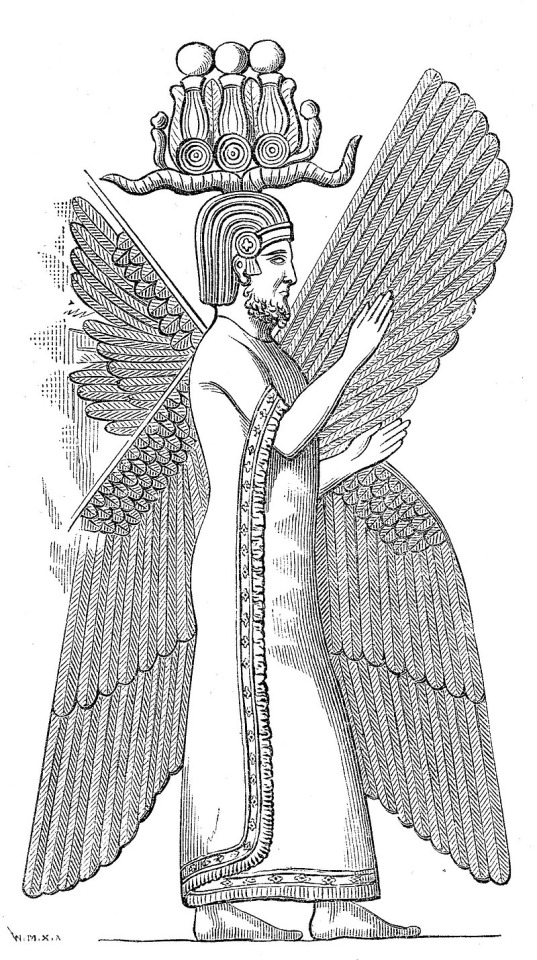
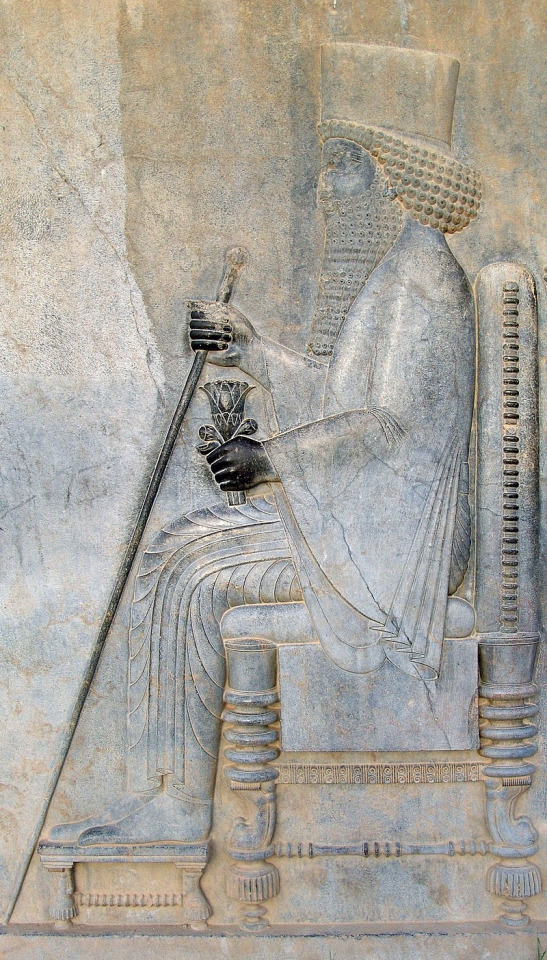

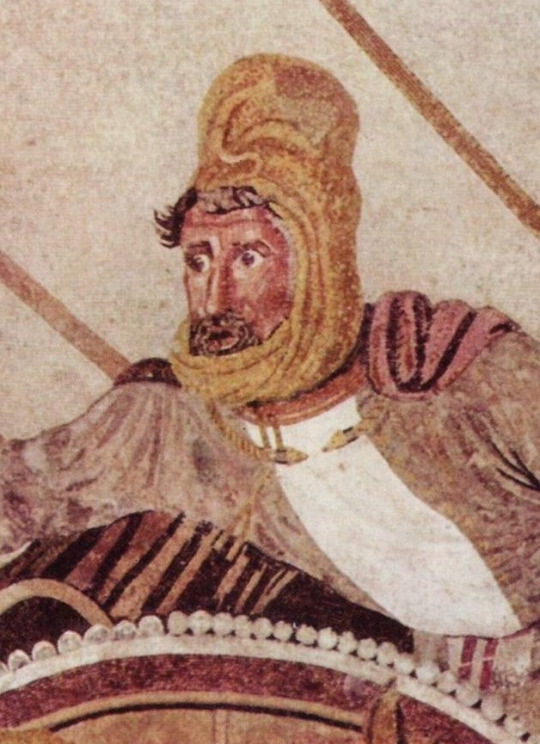
#military history#antiquity#iran#greece#ancient greece#classical greece#ancient ruins#ancient iran#ancient persia#achaemenid#persia#zoroastrianism#alexander the great#cyrus the great#xerxes#artwork#government#history#persian empire#ancient egypt
107 notes
·
View notes
Text
Did the Achaemenids have throne names?

When Ochus, the son of Artaxerxes I, ascended the throne in 424/423 BCE after defeating his brother, he adopted the name "Darius" (𐎭𐎠𐎼𐎹𐎺𐎢𐏁, Dārayavaʰuš). This provides the earliest evidence that Achaemenid kings assumed throne names, which might differ from their original names. These throne names served strong legitimizing purposes: Ochus, whose reign was contested, sought to convey his strength and right to rule by adopting the name of one of his most illustrious predecessors.
But were throne names assigned when a prince was designated as heir to the empire, as was the case in the Neo-Assyrian Empire? This remains uncertain. Additionally, did the practice of using throne names predate Darius II? This is possible, as several Greek sources—Herodotus and Strabo in particular—suggest that even the great Cyrus was not born with the name by which he is known.
Interestingly, some scholars argue that the name Cyrus (𐎤𐎢𐎽𐎢𐏁, Kūruš) is not of Indo-Iranian origin. Some suggest it might derive from Elamite, while Strabo (15.3.6) claims the name comes from a river flowing through Persis near Pasargadae. If Cyrus’s name was indeed non-Iranian, it could support the theory that "Cyrus" was a throne name, as it would make more sense if he were born with a distinct Iranian name. However, this remains a matter of debate.
#achaemenid#persia#iran#ancientiran#ancientpersia#persianhistory#persianculture#iranhistory#iranart#darius#cyrusthegreat#dariusthegreat#ancient#ancientart#ancienthistory#antiquité#antichità
11 notes
·
View notes
Note
do you know of any ancient egyptian deities (other than bes? ) who were worshipped in mesopotamia
ancient Egyptians seemed to have adopted some of their neighbour's deities (like resheph and anat) but it doesn't seem like their deities themselves were ever worshipped outside of egypt (before the cult of isis that is)
Iirc what was possible to establish is only that a figure common in glyptic art was possibly patterned on Bes, and that his name may or may not have influenced Pazuzu's (source; but there are multiple alternatives in this case). Iconography can travel separately from the theological idea of a specific deity, as the adoption of Taweret as a generic apotropaic(?) creature, the "Minoan genius", in Minoan art shows. Since transfer of Bes would like occur similarly - through apotropaic objects meant for domestic use - I'd be cautious with evaluating if we are dealing with genuine Bes in this context, but I am not really aware of any recent studies which would explore this topic, so the 1990s consensus doesn't need to be undermined either. "It doesn't seem like their deities themselves were ever worshipped outside of egypt" is incorrect but you should be looking at Byblos and Kush first and foremost, not Mesopotamia. There's a recent article on the pantheon of Kush here, I can't recommend a single source when it comes to Byblos atm but you should get some solid sources from the bibliography of the Baalat Gebal article I wrote on wikipedia a few months ago. There's ample evidence for the reception of Thoth in Phoenicia in particular. Also, reception of Egyptian deities in the Greco-Roman world later on was not limited to Isis either, the oracle of Amon enjoyed considerable popularity iirc. Mesopotamia and Egypt were not particularly close culturally let alone theologically before the first millennium BCE when the Neo-Assyrian empire came to control Egypt, and even then, the reception of Egyptian ideas in Mesopotamia is a pretty complicated matter, see here (note the article is wrong about the connection between Humban and Napirisha, they were not the same deity). For a recent overview of textual evidence for Egypt-Mesopotamia contacts see here. The Amarna excavations did show that Egypt must have maintained a cadre of diplomats who learned how to write in Akkadian and there was obviously the exchange of letters with Kassite and Middle Assyrian rulers but ultimately the main groups to converse in Akkadian with would be the elites of various Syrian statelets and Hittite diplomats, not the Mesopotamians themselves. It did not necessarily require theological knowledge, also, seeing as the Egyptian versions of bilingual treaties at times get the gender of deities wrong. When it comes to incorporation of foreign deities into Egyptian religion, see here. Something worth highlighting is that for some reason when it comes to the north, save for Baalat Gebal and Horon most of the deities do not seem to come from the immediate proximity of Egyptian borders: Resheph and Anat were hardly worshiped south of Ugarit on the coast, they were "middle Euphrates" deities first and foremost, and the Egyptian Ashtart shows more similarity to Ugaritic evidence than anything. On the Mesopotamian side, foreign deities - usually Hurrian ones, with Shaushka being particularly well attested, less commonly Elamite, Amorite or Kassite - were usually incorporated in peripheral areas where Mesopotamian and non-Mesopotamian culture intersected - so places like the Middle Euphrates, Susiana or Arrapha (around modern Kirkuk).
12 notes
·
View notes
Text
Christian Carey's year in review

2023 was pretty much an awful year for our world —climate disaster moves ever more quickly, violence abounds and US politics are a disaster. I would not write a thank you card to the universe for many of my own experiences during the year either. However, I am grateful for the extraordinary music I participated in, heard and wrote about: it was a great solace. A few highlights are below:
I composed three new pieces: Solemn Tollings, for microtonal trumpet and trombone, Just Like You for singing violist, and Cracking Linear Elamite for solo guitar. The latter premiered in December at Loft 393 in Tribeca, played by Dan Lippel.
In addition to editing Sequenza 21 and contributing to Dusted, I authored several reviews and a research article for the British journal Tempo. The article was on my research in narratology as a feature of Elliott Carter’s music, which I have been exploring and publishing on since writing my Ph.D. dissertation. It was great for this particular research, of character-types and interactions in the Fifth String Quartet, to finally see the light of day.
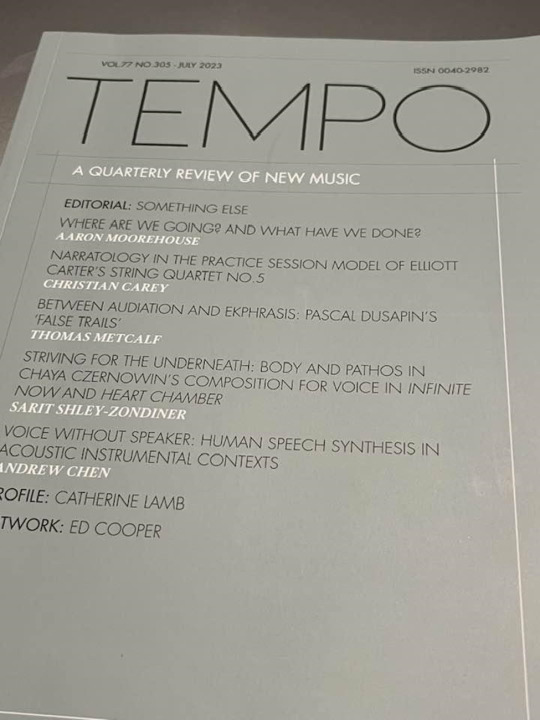
After a half-century of banged up and often unreliable used pianos, my wife Kay got me a new Baldwin grand piano for my 50th birthday. Since it has arrived, I have practically lived in it.
Post-pandemic and post-cancer, I began to dip my toe into attending live events. I went to the Tanglewood Festival of Contemporary Music, which was a mixed bag. As compensation, the Boston Symphony performances that weekend were excellent. I attended a great concert at the New York Philharmonic in November and another in December. For many years, Kay and I have made a holiday tradition of seeing the Tallis Scholars at St. Mary the Virgin Church in midtown. It was wonderful to return there. The Tallis Scholars’ performance was splendid, featuring a mass by Clemens non Papa.
After the Tallis concert, Kay was in Nashville, where her parents live, for two weeks, spending time with her brother Tom and sister-in-law Aymara, who were visiting from Qatar (Tom teaches at the Carnegie Mellon University campus there and Aymara is a yoga instructor), and celebrating Christmas with her parents. Here in New Jersey, it was just me and the felines, who were (mostly) well-behaved. To keep the holiday blues at bay, I went all out, decorating a natural tree and the house. I played every carol in the hymnal, and enjoyed old holiday standbys: Oscar Peterson, Dave Brubeck, and Mel Torme’s Christmas albums.

youtube
There was much excellent recorded music released this year, and I will not attempt to document it all. Here are twelve records, in no particular order, that I expect will stay with me and be played often in coming years.
2023 Favorite Recordings
Yo La Tengo — This Stupid World (Matador)
Hilary Hahn — Eugène Ysaÿe’s Six Sonatas for Violin Solo, op. 27 (DG)
Morton Feldman — Violin and String Quartet (Another Timbre)
Natural Information Society — Since Time is Gravity (Eremite)
Leah Bertucci — Of Shadow and Substance (Self— released)
Juliet Fraser — What of Words and What of Song (Neos)
Laura Strickling and Daniel Schlosberg — 40@40 (Bright Shiny Things)
Emily Hindricks, WDR Sinfonieorchester Köln, and Cristian Macelaru perform Liza Lim — Annunciation Triptych (Kairos)
Bozzini Quartet and Konus Quartett play Jürg Frey — Continuité, fragilité, résonance (elsewhere)
Matana Roberts — Coin Coin Chapter Five (Constellation)
Chris Forsyth — Solar Motel (self— released)
John Luther Adams — Darkness and Scattered Light (Cold Blue)
Christian Carey
#dusted magazine#yearend 2023#christian carey#elliott carter#tempo#tanglewood#tallis scholars#yo la tengo#hilary hahn#morton feldman#natural information society#leah bertucci#juliet fraser#laura strickling#daniel schlosberg#emilty hindricks#bozzini quartet#konus quartett#matana roberts#chris forsyth#john luther adams
4 notes
·
View notes
Text

vessel fragment in the form of a nude female | ca. 700s BCE | neo-elamite
in the met museum collection
28 notes
·
View notes
Text
Deciphering The Elamite Language
Elamite was the language of Elam, an ancient civilization centered in what is now southwestern Iran. The language was written in cuneiform script and was used from around 2300 BCE to 350 BCE. The decipherment of Elamite presents an interesting case study in historical linguistics because we have texts in three different phases of the language: Old, Middle, and Neo-Elamite. The initial…
0 notes
Text
-Sumer
-interregnum
-Akkad
-gutian invasion
-neo sumerian
-amorites
-amorite kingdoms and babylon
-Hamurabi and the empire
-Assyrians invade and conquer, rule with puppets
-Kassites come from the Zargos mountains and establish their dynasty
-The Kassites were succeeded by the Elamites, who themselves were conquered by Marduk-kabit-ahheshu (native), the founder of the Second Dynasty of Isin.
0 notes
Text

Empire, now known as the Old Babylonian Empire, in the 19th century BC. The Amorite king Hammurabi founded the short-lived Old Babylonian Empire in the 18th century BC. He built Babylon into a major city and declared himself its king. Southern Mesopotamia became known as Babylonia, and Babylon eclipsed Nippur as the region's holy city. The empire waned under Hammurabi's son Samsu-ilund, and Babylon spent long periods under Assyrian, Kassite and Elamite domination. After the Assyrians had destroyed and then rebuilt it, Babylon became the capital of the short-lived Neo-Babylonian Empire from 609 to 539 BC.
The Hanging Gardens of Babylon ranked as one of the Seven Wonders of the Ancient World.
After the fall of the Neo-Babylonian Empire, the city came under the rule of the Achaemenid, Seleucid, Parthian, Roman, Sassanid, and Muslim empires. The last known habitation of the town dates from the 10th century AD, when it was referred to as the "small village of Babel".
It has been estimated that Babvlon was the largest city in the world c. 1770 - c. 1670 BC, and again c. 612 - c. 320 BC. It was perhaps the first city to reach a population above 200,000. [3] Estimates for the maximum extent of its area range from 890[4] to 900 ha (2,200 acres). [5]
The remains of the city are in present-day Hillah, Babil Governorate, Iraq, about 85 km (53 mi) south of Baghdad, and its boundaries as CLONES
1 note
·
View note